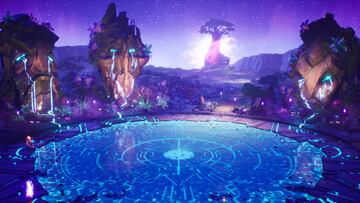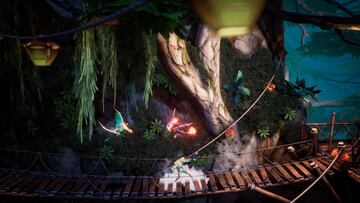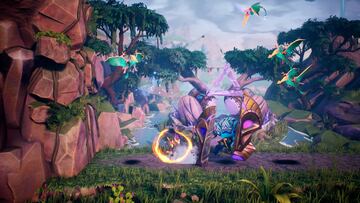Surgent Studios
Tales of Kenzera: ZAU - A touching adventure with heavy potential
Surgent Studios’ debut title, Tales of Kenzera: ZAU brings players a very powerful story, and works as a good foundation for the future of the studio

In the current state of the industry, many titles tend to go unseen by audiences due to their size or lack of recognizable properties or licenses. But every so often, a smaller studio gets a huge opportunity to show off what they’re capable of with a platform to present their own game. Such is the case with Tales of Kenzera: ZAU, the debut title of Surgent Studios and a very personal and emotional story about grief, love, and the loss of a parent that mirrors its director’s own experience.
Having been presented during the 2023 Game Awards, Tales of Kenzera: ZAU suddenly got heaps of attention by being presented as a title of many firsts: It is the first game developed by a new studio, the directorial debut of prolific actor Abubakar Salim, known in the industry for his role as Assassin’s Creed Origin’s protagonist, the first major title of a publisher like EA that delves into African mythology and culture, and many firsts more. So now, almost a year after its revelation and having played the game, how has the game fared?
While there are some issues to be found in the title at the time of speaking (before any major patches and updates have been released), it is undeniable that the passion of this entire team has delivered something many can only dream of. A fantastic presentation and a gripping story keeps players hooked for its relatively shorter length, and its combat and traversal mechanics have the potential to put you in a Zen state like few others are able to.
A human story wrapped in a fantastic world
Tales of Kenzera: ZAU tells the story of Zuberi, a young boy who’s left grieving the sudden death of his father. While clearly in despair and harrowed, he finds a way to connect with his parent through a book that was left for him. In it, he finds a tale of a young shaman called Zau who is himself dealing with the death of his father, except he goes on a quest to make a deal with Kalunga, the god of Death, to bring back his father no matter the price.
As we mentioned in our preview, the story of Zuberi and Zau act as parallels, with both of them being all about coming to terms with the recent passing of their father. Director Abubakar Salim clearly poured his heart into the story, having lost his own father and being inspired by his journey of grieving to create a piece of art that reflects his feeling. The game is emotionally charged at every moment of the adventure, with Zau meeting other characters during his journey to send three great spirits in order to bargain with Kalunga, all of which are dealing with their own grief.

As such, every moment in the story is an identifiable step of grief, showing how little by little someone is able to deal with their own feelings after the loss of a loved one. It is a feeling that almost every person will have to go through, and although it’s not a very pleasant one, the catharsis of going through is the entire point of the experience. And just as such, Tales of Kenzera: Zau doesn’t pull any punches when it comes to presenting his own protagonists going through the wringer.
The story and how it is presented is by far the most outstanding part of this title, and it appears to be the main focus of the developers as well. Everything in Tales of Kenzera revolves around its story and lore, not just in the dialog between characters (of which there is plenty) but contextualized through every aspect of the title. You meditate inside giant Baobab trees to extend your health bar, learn traditional stories of the region to obtain powerful abilities and artifacts, and every enemy you encounter are restless spirits that refuse to accept their passage to the afterlife.

As we’ve mentioned before, the visuals in the game are incredibly important to the experience, and they shine brightly with their distinctive vivid colors and unique art style. The developers created a world that mixes Bantu myth and culture with Afrofuturism, which results in a distinctive look for every aspect of the map you explore. Each region is well defined, from floating mountains to murky swamps, all of them filled with remnants of civilization that mirror real-life culture in their own way. This style is seldom explored in video games, so to see it as fleshed out as it is in Tales of Kenzera: ZAU is fantastic.
Sprinting out of the starting line, but tripping along the way
Mixed with the rest of the experience, the gameplay is well beyond just serviceable when looking at the larger picture. But unfortunately the closer you look, the more cracks start appearing that make it clear that this isn’t a perfect Metroidvania like we’ve hoped it was. That’s not to say that it’s a terrible game, far from it, but it is disappointing in that it’s not quite what we expected when we heard the term “Metroidvania”.
From the very start of the game, you’re given a very complete moveset that many veterans of the genre will be familiar with: a double jump, an air dash, wall jumping, and an incredibly nimble movement speed. As such, you’d expect to be using that and everything else you unlock to travel through the world finding secrets and achieving platforming feats while fighting many monsters on the way. However, while movement feels great, it turns out that there’s not much to do in the way of exploring after all.

In actuality, Tale of Kenzera: ZAU is actually quite a linear experience, only being “open” in the surface. The entire game is well defined by chapters, with each region hiding only a few secrets that can be accomplished once you obtain the abilities in each one. What that means is that you won’t need to backtrack to previous regions with later abilities, as everything is contained to whatever you find in said area. There is very little mystery to the map, with a heavily marked path for you to travel through and little to no alternate routes to take.
However, the map is very large and will see you focused on platforming and tricky jumps at almost every turn instead. These constant challenges make great use of your traversal abilities, which when mixed with the wide variety of environments you move through in your journey can be more than enough for some players to feel like they’re on an exciting adventure. The distances you travel also seem almost measured to allow for the many lines of dialog that take place in real time while you move, further expanding on the story and the main themes of the games.

Where you’ll be ground to a halt however is during combat sequences, which are not as pronounced as we thought at first but still constant enough that they’ll almost become annoying to some. That is because while your combat abilities are fun, with the two masks you can switch between giving you both melee and ranged skills, your enemies are not quite as entertaining. There are very few enemy types to contend with, and even when new versions are introduced at later points in the game, almost every encounter you’re faced with is extremely similar. Most encounters see you trapped in a room with a few platforms, in which two or three waves of enemies spawn in and you’re tasked with eliminating them before moving on.
You’ll always get a few melee grunts rushing at you, while the same fixed ranged enemies shoot projectiles from the sides of the arena. Later, smaller enemies that run at you and explode are added, and even later you get bigger melee enemies, one type of flying creature, and eventually a mini-boss that takes way too much damage to take off without much excitement in the way you deal with it. Eventually you’ll have to switch masks to even damage them, but combat never really reaches a point were it’s complex or engaging, even becoming dull and useless except to gain skill points to be better prepared for the few bosses that actually pose a challenge.
All in all, the game doesn’t quite live up to its Metroidvania tag, but it’s still a fantastic first project for Surgent Studios that proves that they have heaps of potential for creating games. This time, Tales of Kenzera: ZAU is carried high by its presentation and its story (as well as its fantastic music and voice acting), but smaller issues with both its design and certain design sensibilities that might go unnoticed by many hold it back from greatness.


